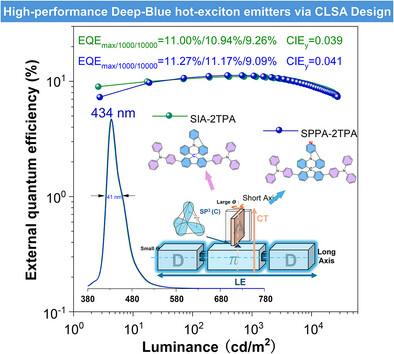采用具有快速激子动力学的热激子发射器的高效稳定的深蓝oled:在10,000 cd m−2下,CIEy <0.046, EQEs超过9%
IF 19
1区 材料科学
Q1 CHEMISTRY, MULTIDISCIPLINARY
引用次数: 0
摘要
为了实现宽色域的全彩显示,开发具有高亮度和低滚降效率的高性能深蓝有机发光二极管(oled)是必不可少的。在这里,该研究报告了两种基于交叉长短轴(CLSA)分子设计策略的新型深蓝色发射器,结合sp3杂化碳桥来创建独特的杂化局部和电荷转移(HLCT)激发态。除了在光致发光中表现出高色纯度的深蓝色发射和高量子产率外,这些新型发射体在CIE坐标(0.155,0.039)和(0.155,0.041)处分别实现了11.0%和11.3%的优异的最大外部量子效率(EQEs)。此外,它们在10,000 cd m−2的超高亮度下保持了9.3%和9.1%的高EQEs,代表了迄今为止报道的CIEy≤0.046的深蓝oled的最佳性能。理论计算表明,这些结果源于双通道热激子过程加速的激子动力学,由调节激发态行为的sp3杂化耦合模式促进。本研究表明,调整CLSA策略中长轴和短轴之间的耦合模式对于提高器件性能具有重要意义,特别是在开发具有高亮度和低效率滚转的高性能深蓝OLED发射器方面。本文章由计算机程序翻译,如有差异,请以英文原文为准。

Efficient and Stable Deep-Blue OLEDs Employing Hot-Exciton Emitters with Rapid Exciton Dynamics: Achieving High EQEs Over 9% at 10 000 cd m−2 with CIEy <0.046
To achieve full-color displays with wide gamuts, developing high-performance deep-blue organic light-emitting diodes (OLEDs) with both high luminance and low efficiency roll-off is essential. Here, the study reports two new deep-blue emitters based on a crossed long-short axis (CLSA) molecular design strategy, incorporating a sp3-hybridized carbon bridge to create unique hybridized local and charge-transfer (HLCT) excited states. In addition to exhibiting high color-purity deep-blue emissions and high quantum yields in photoluminescence, these new emitters achieve excellent maximum external quantum efficiencies (EQEs) of 11.0% and 11.3% at CIE coordinates of (0.155, 0.039) and (0.155, 0.041), respectively. Furthermore, they maintain high EQEs of 9.3% and 9.1% at an ultrahigh luminance of 10 000 cd m−2, representing the best performance reported to date for deep-blue OLEDs with CIEy ≤ 0.046. Theoretical calculations suggest these results originate from accelerated exciton dynamics via a dual-channel hot-exciton process, facilitated by the sp3-hybridized coupling mode that modulates excited-state behavior. This work demonstrates that adjusting the coupling mode between long and short axis in CLSA strategy has significant implications for improving device performance, especially in the development of high-performance deep-blue OLED emitters with high luminance and low efficiency roll-off.
求助全文
通过发布文献求助,成功后即可免费获取论文全文。
去求助
来源期刊

Advanced Functional Materials
工程技术-材料科学:综合
CiteScore
29.50
自引率
4.20%
发文量
2086
审稿时长
2.1 months
期刊介绍:
Firmly established as a top-tier materials science journal, Advanced Functional Materials reports breakthrough research in all aspects of materials science, including nanotechnology, chemistry, physics, and biology every week.
Advanced Functional Materials is known for its rapid and fair peer review, quality content, and high impact, making it the first choice of the international materials science community.
 求助内容:
求助内容: 应助结果提醒方式:
应助结果提醒方式:


